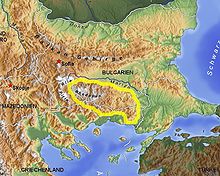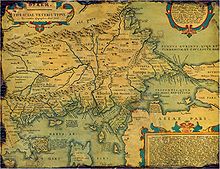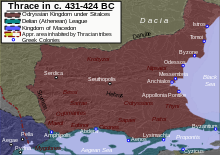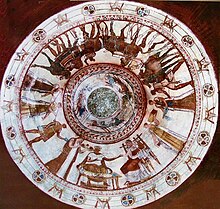This is an old revision of this page, as edited by Alexikoua (talk | contribs) at 07:48, 31 December 2014 (rv undo weight about short term Persian occupation). The present address (URL) is a permanent link to this revision, which may differ significantly from the current revision.
Revision as of 07:48, 31 December 2014 by Alexikoua (talk | contribs) (rv undo weight about short term Persian occupation)(diff) ← Previous revision | Latest revision (diff) | Newer revision → (diff) For other uses, see Thrace (disambiguation).





Thrace /ˈθreɪs/ (demonym Thracian /ˈθreɪʃən/; Template:Lang-grc, Thrāikē; modern Template:Lang-el, Thráki; Template:Lang-bg, Trakija; Template:Lang-tr) is a historical and geographic area in southeast Europe, centered on the modern borders of Bulgaria, Greece, and Turkey. As a geographical concept, Thrace designates a region bounded by the Balkan Mountains on the north, Rhodope Mountains and the Aegean Sea on the south, and by the Black Sea and the Sea of Marmara on the east. The areas it comprises are southeastern Bulgaria (Northern Thrace), northeastern Greece (Western Thrace), and the European part of Turkey (Eastern Thrace). The biggest part of Thrace is part of present-day Bulgaria. In Turkey, it is also called Rumeli. The name comes from the Thracians, an ancient Indo-European people inhabiting Southeastern Europe.
Etymology
The name appears to derive from an ancient heroine and sorceress Thrace, who was the daughter of Oceanus and Parthenope, and sister of Europa. The word itself derives from the Latin Thrācia, which comes from Ancient Greek Thrākē (Θρᾴκη), descending from Thrāks (Θρᾱξ/Θρᾴξ), meaning “Thracian”, ultimately being derived from thrāssō, meaning “to trouble, stir”.
Geography
Borders
The historical boundaries of Thrace have varied. Noteworthy is the fact that, at an early date, the ancient Greeks employed the term "Thrace" to refer to all of the territory which lay north of Thessaly inhabited by the Thracians, a region which "had no definite boundaries" and to which other regions (like Macedonia and even Scythia) were added. In one ancient Greek source, the very Earth is divided into "Asia, Libya, Europa and Thracia". As the knowledge of world geography of the Greeks broadened, the term came to be more restricted in its application: Thrace designated the lands bordered by the Danube on the north, by the Euxine Sea (Black Sea) on the east, by northern Macedonia in the south and by Illyria to the west. This largely coincided with the Thracian Odrysian kingdom, whose borders varied over time. During this time, specifically after the Macedonian conquest, the region's old border with Macedonia was shifted from the Struma River to the Mesta River. This usage lasted until the Roman conquest. Henceforth, (classical) Thrace referred only to the tract of land largely covering the same extent of space as the modern geographical region. In its early period, the Roman province of Thrace was of this extent, but after the administrative reforms of the late 3rd century, Thracia's much reduced territory became the six small provinces which constituted the Diocese of Thrace. The medieval Byzantine theme of Thrace contained only what today is Eastern Thrace.
Cities of Thrace
Main article: List of cities of ThraceThe largest cities of Thrace are: Byzantium (İstanbul), Plovdiv, Burgas, Stara Zagora, Haskovo, Komotini, Alexandroupoli, Edirne, Çorlu and Tekirdağ.
Demographics and religion
Main articles: Demographics of Bulgaria, Demographics of Greece, and Demographics of Turkey See also: Thracian Bulgarians and Turks of Western ThraceMost of the Bulgarian and Greek population are Christians, while most of the Turkish inhabitants of Thrace are Muslims.
Thrace in ancient Greek mythology
Ancient Greek mythology provides them with a mythical ancestor, named Thrax, son of the war-god Ares, who was said to reside in Thrace. The Thracians appear in Homer's Iliad as Trojan allies, led by Acamas and Peiros. Later in the Iliad, Rhesus, another Thracian king, makes an appearance. Cisseus, father-in-law to the Trojan elder Antenor, is also given as a Thracian king. Homeric Thrace was vaguely defined, and stretched from the River Axios in the west to the Hellespont and Black Sea in the east. The Catalogue of Ships mentions three separate contingents from Thrace: Thracians led by Acamas and Peiros, from Aenus; Cicones led by Euphemus, from southern Thrace, near Ismaros; and from the city of Sestus, on the Thracian (northern) side of the Hellespont, which formed part of the contingent led by Asius. Greek mythology is replete with Thracian kings, including Diomedes, Tereus, Lycurgus, Phineus, Tegyrius, Eumolpus, Polymnestor, Poltys, and Oeagrus (father of Orpheus). In addition to the tribe that Homer calls Thracians, ancient Thrace was home to numerous other tribes, such as the Edones, Bisaltae, Cicones, and Bistones.
Thrace is also mentioned in Ovid's Metamorphoses in the episode of Philomela, Procne, and Tereus. Tereus, the King of Thrace, lusts after his sister-in-law, Philomela. He kidnaps her, holds her captive, rapes her, and cuts out her tongue. Philomela manages to get free, however. She and her sister, Procne, plot to get revenge, by killing Itys (son of Tereus and Procne) and serving him to his father for dinner. At the end of the myth, all three turn into birds—Procne, a swallow; Philomela, a nightingale; and Tereus, a hoopoe.
History
See also: History of Western Thrace and History of East ThraceAncient history
Main article: Thracians
The indigenous population of Thrace was a people called the Thracians, divided into numerous tribal groups. A large part of the region was at times controlled by the Persian Empire at its greatest extent, and Thracian soldiers were known to be used in the Persian armies. Later on, Thracian troops were known to accompany neighboring ruler Alexander the Great when he crossed the Hellespont which abuts Thrace, and took on the Persian Empire itself.
The Thracians did not describe themselves by name; terms such as Thrace and Thracians are simply the names given them by the Greeks.
Divided into separate tribes, the Thracians did not form any lasting political organizations until the founding of the Odrysian state in the 4th century BC. Like Illyrians, the locally ruled Thracian tribes of the mountainous regions maintained a warrior tradition, while the tribes based in the plains were purportedly more peaceable. Recently discovered funeral mounds in Bulgaria suggest that Thracian kings did rule regions of Thrace with distinct Thracian national identity.
During this period, a subculture of celibate ascetics called the Ctistae lived in Thrace, where they served as philosophers, priests and prophets.
After the conquests of Alexander the Great and throughout Roman times, Thrace became increasingly hellenized.
Medieval history
Main articles: Macedonia (theme) and Thrace (theme)By the mid 5th century, as the Roman Empire began to crumble, Thracia fell from the authority of Rome and into the hands of Germanic tribal rulers. With the fall of Rome, Thracia turned into a battleground territory for the better part of the next 1,000 years. The surviving eastern portion of the Roman Empire in the Balkans, later known as the Byzantine Empire, retained control over Thrace until the 8th century when the northern half of the entire region was incorporated into the First Bulgarian Empire and the remainder was reorganized in the Thracian theme. Byzantium regained the lost regions in the late 10th century and administered until the Bulgarians regained control of the northern half at the end of the 12th century. Throughout the 13th century and the first half of the 14th century, the region was changing in the hands of the Bulgarian and the Byzantine Empire (excluding Constantinople). In 1265 the area suffered a Mongol raid from the Golden Horde, led by Nogai Khan, and between 1305 and 1307 was raided by the Catalan company.
Ottoman period

In 1352, the Ottoman Turks conducted their first incursion into the region subduing it completely within a matter of two decades and occupying it for five centuries. In 1821, several parts of Thrace, such as Lavara, Maroneia, Sozopolis, Aenos, Callipolis and Samothraki rebelled during the Greek War of Independence.
Modern history

With the Congress of Berlin in 1878, Northern Thrace was incorporated into the semi-autonomous Ottoman province of Eastern Rumelia, which united with Bulgaria in 1885. The rest of Thrace was divided among Bulgaria, Greece and Turkey at the beginning of the 20th century, following the Balkan Wars, World War I and the Greco-Turkish War. Today Thracian is a geographical term used in Greece, Turkey and Bulgaria.
Famous Thracians and people from Thrace
- Spartacus was a Thracian auxiliary soldier in the Roman army who deserted but was captured and then enslaved by the Romans. He led a large slave uprising in what is now Italy in 73–71 BC. His army of escaped gladiators and slaves defeated several Roman legions in what is known as the Third Servile War.
- Belisarius, one of the most successful Generals of the Roman Empire, was born in the borderlands between Thrace and Illyria.
- In Ancient Greek mythology, Orpheus was the chief representative of the art of song and playing the lyre.
- Democritus was a Greek philosopher and mathematician from Abdera, Thrace (c. 460–370 BC.) His main contribution is the atomic theory, the belief that all matter is made up of various imperishable indivisible elements which he called atoms.
- Herodicus was a Greek physician of the fifth century BC who is considered the founder of sports medicine. He is believed to have been one of Hippocrates' tutors.
- Protagoras was a Greek philosopher from Abdera, Thrace (c. 490–420 BC.) An expert in rhetorics and subjects connected to virtue and political life, often regarded as the first sophist. He is known primarily for three claims (1) that man is the measure of all things, often interpreted as a sort of moral relativism, (2) that he could make the "worse (or weaker) argument appear the better (or stronger)" (see Sophism) and (3) that one could not tell if the gods existed or not (see Agnosticism).
- A number of Roman emperors of the 3rd-5th century were of Thraco-Roman backgrounds (Maximinus Thrax, Licinius, Galerius, Aureolus, Leo the Thracian, etc.). These emperors were elevated via a military career, from the condition of common soldiers in one of the Roman legions to the foremost positions of political power.
Honours
Trakiya Heights in Antarctica "are named after the historical region of Trakiya (Thrace)."
See also
- 1934 Thrace Pogroms
- 1989 expulsion of Turks from Bulgaria
- Celtic settlement of Eastern Europe
- Dacia
- Dardania
- Macedon
- Moesia
- Moesogoths
- Music of Thrace
- Paionia
- The Destruction of Thracian Bulgarians in 1913
- Turkish Republic of Thrace
- Turks of Western Thrace
Notes
- Θρᾴκη. Liddell, Henry George; Scott, Robert; A Greek–English Lexicon at the Perseus Project
- Swinburne Carr, Thomas. The history and geography of Greece. p. 56.
- ^ Smith, Sir William (1857). Dictionary of Greek and Roman geography. London. p. 1176.
{{cite book}}: CS1 maint: location missing publisher (link) - Johann Joachim Eschenburg, Nathan Welby Fiske. Manual of classical literature. p. 20.
- Adam, Alexander. A summary of geography and history, both ancient and modern. p. 344.
- The Cambridge Ancient History, Volume 3, Part 2: The Assyrian and Babylonian Empires and Other States of the Near East, from the Eighth to the Sixth Centuries BC by John Boardman, I. E. S. Edwards, E. Sollberger, and N. G. L. Hammond ,ISBN 0-521-22717-8,1992,page 597: "We have no way of knowing what the Thracians called themselves and if indeed they had a common name...Thus the name of Thracians and that of their country were given by the Greeks to a group of tribes occupying the territory..."
- La Venjança catalana. Gran Enciclopèdia Catalana.
- Trakiya Heights. SCAR Composite Antarctic Gazetteer.
References
- Hoddinott, R. F., The Thracians, 1981.
- Ilieva, Sonya, Thracology, 2001
External links
- Ethnological Museum of Thrace, comprehensive website on Thracian history and culture.
- Bulgaria's Thracian Heritage. including images of the comprehensive art collection of Thracian gold found on the territory of contemporary Bulgaria.
- Information on Ancient Thrace